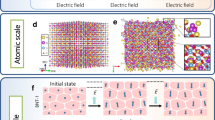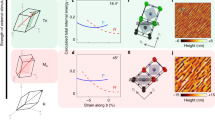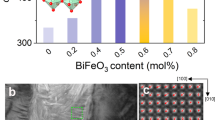Abstract
Piezoelectric actuators transform electrical energy into mechanical energy, and because of their compactness, quick response time and accurate displacement, they are sought after in many applications. Polycrystalline piezoelectric ceramics are technologically more appealing than single crystals due to their simpler and less expensive processing, but have yet to display electrostrain values that exceed 1%. Here we report a material design strategy wherein the efficient switching of ferroelectric–ferroelastic domains by an electric field is exploited to achieve a high electrostrain value of 1.3% in a pseudo-ternary ferroelectric alloy system, BiFeO3–PbTiO3–LaFeO3. Detailed structural investigations reveal that this electrostrain is associated with a combination of several factors: a large spontaneous lattice strain of the piezoelectric phase, domain miniaturization, a low-symmetry ferroelectric phase and a very large reverse switching of the non-180° domains. This insight for the design of a new class of polycrystalline piezoceramics with high electrostrains may be useful to develop alternatives to costly single-crystal actuators.
This is a preview of subscription content, access via your institution
Access options
Access Nature and 54 other Nature Portfolio journals
Get Nature+, our best-value online-access subscription
$29.99 / 30 days
cancel any time
Subscribe to this journal
Receive 12 print issues and online access
$259.00 per year
only $21.58 per issue
Buy this article
- Purchase on Springer Link
- Instant access to full article PDF
Prices may be subject to local taxes which are calculated during checkout






Similar content being viewed by others
References
Uchino, K. Piezoelectric Actuators and Ultrasonic Motors (Kluwer Academic, Boston, 1996).
Park, S.-E. & Shrout, T. R. Ultrahigh strain and piezoelectric behavior in relaxor based ferroelectric single crystals. J. Appl. Phys. 82, 1804–1811 (1997).
Du, X., Belegundu, U. & Uchino, K. Crystal orientation dependence of piezoelectric properties in lead zirconate titanate: theoretical expectation for thin films. Jpn J. Appl. Phys. 36, 5580–5587 (1997).
Hall, D. A., Steuwer, A., Cherdhirunkorn, B., Mori, T. & Withers, P. J. Analysis of elastic strain and crystallographic texture in poled rhombohedral PZT ceramics. Acta Mater. 54, 3075–3083 (2006).
Li, J. Y., Rogan, R. C., Üstündag, E. & Bhattacharya, K. Domain switching in polycrystalline ferroelectric ceramics. Nat. Mater. 4, 776–781 (2005).
Liu, X. & Tan, X. Giant strains in non-textured (Bi1/2Na1/2)TiO3-based lead-free ceramics. Adv. Mater. 28, 574–578 (2016).
Damjanovic, D. Ferroelectric, dielectric and piezoelectric properties of ferroelectric thin films and ceramics. Rep. Prog. Phys. 61, 1267–1324 (1998).
Jones, J. L., Hoffman, M., Daniels, J. E. & Studer, A. J. Direct measurement of the domain switching contribution to the dynamic piezoelectric response in ferroelectric ceramics. Appl. Phys. Lett. 89, 092901 (2006).
Fu, H. & Cohen, R. E. Polarization rotation mechanism for ultrahigh electromechanical response in single-crystal piezoelectrics. Nature 403, 281–283 (2000).
Wada, S., Park, S.-E., Cross, L. E. & Shrout, T. R. Domain configuration and ferroelectric related properties of relaxor based single crystals. J. Kor. Phys. Soc. 32, S1290–S1293 (1998).
Ren, X. Large electric-field-induced strain in ferroelectric crystals by point defect mediated reversible domain switching. Nat. Mater. 3, 91–94 (2004).
Xu, G., Zhong, Z., Bing, Y., Ye, Z.-G. & Shirane, G. Electric-field-induced redistribution of polar nano-regions in a relaxor ferroelectric. Nat. Mater. 5, 134–138 (2006).
Fedulov, S. A., Ladyzhinskii, P. B., Pyatigorskaya, I. L. & Venevetsev, Yu. N. Complete phase diagram of the PbTiO3-BiFeO3 system. Sov. Phys. Solid State 6, 375–378 (1964).
Comyn, T. P. et al. Phase-specific magnetic ordering in BiFeO3−PbTiO3. Appl. Phys. Lett. 93, 232901 (2008).
Dai, X., Xu, Z. & Viehland, D. J. Normal to relaxor ferroelectric transformations in lanthanum-modified tetragonal structured lead zirconate titanate ceramics. J. Appl. Phys. 79, 1021–1026 (1996).
Howard, C. J. & Stokes, H. T. Group-theoretical analysis of octahedral tilting in perovskites. Acta Cryst. B54, 782–789 (1998).
Stokes, H. T., Kisi, E. H., Hatch, D. M. & Howard, C. J. Group-theoretical analysis of octahedral tilting in ferroelectric perovskites. Acta Cryst. B58, 934–938 (2002).
Grinberg, I., Cooper, V. R. & Rappe, A. M. Relationship between local structure and phase transitions of a disordered solid solution. Nature 419, 909–911 (2002).
Westphal, V., Kleeman, W. & Glinchuk, M. D. Diffuse phase transitions and random-field-induced domain states of the relaxor ferroelectric PbMg1/3Nb2/3O3. Phys. Rev. Lett. 68, 847–850 (1992).
Rao, B. N. et al. Local structural disorder and its influence on the average global structure and polar properties in Na0.5Ba0.5TiO3. Phys. Rev. B 88, 224103 (2013).
Usher, T.-M. et al. Local and average structures of BaTiO3–Bi(Zn1/2Ti1/2)O3. J. Appl. Phys. 120, 184102 (2016).
Ihlefeld, J. F. et al. Scaling effects in perovskite ferroelectrics: fundamental limits and structure–property relations. J. Am. Ceram. Soc. 99, 2537–2557 (2016).
Pramanick, A., Damjanovic, D., Daniels, J. E., Nino, J. C. & Jones, J. L. Origins of electro-mechanical coupling in polycrystalline ferroelectrics during subcoercive electrical Loading. J. Am. Ceram. Soc. 94, 293–309 (2011).
Rong, Y. et al. Large piezoelectric response and polarization in relaxor ferroelectric PbTiO3–Bi(Ni1/2Zr1/2)O3. J. Am. Ceram. Soc. 96, 1035–1038 (2013).
Cheng, J.-R., Eitel, R. & Cross, L. E. Lanthanum-modified (1–x)(Bi0.8La0.2)(Ga0.05Fe0.95)O3.xPbTiO3 crystalline solutions: novel morphotropic phase-boundary lead-reduced piezoelectrics. J. Am. Ceram. Soc. 86, 2111–2115 (2003).
Leist, T., Granzow, T., Jo, W. & Rödel, J. Effect of tetragonal distortion on ferroelectric domain switching: a case study on La doped BiFeO3-PbTiO3 ceramics. J. Appl. Phys. 108, 014103 (2010).
Carvajal, J. R. FULLPROF. A Rietveld refinement and pattern matching analysis program (Laboratories Leon Brillouin (CEA-CNRS), France, 2000).
Acknowledgements
R.R. acknowledges the Special Grant provided by IISc Bangalore in 2013 to set-up the facility to carry out high-resolution XRPD in situ with an electric field (Grant. no. AD/PG/RR/MET-08). R.R. also acknowledges the Nano mission Program of the Department of Science and Technology (Grant no. SR/NM/NS-1010/2015 (G)), the Council of Scientific and Industrial Research (Grant no. 03 (1347)/16/EMR-II) and the Science and Engineering Research Board (SERB) of the Ministry of Science and Technology (Grant no. EMR/2016/001457), Government of India for financial support. R.P. acknowledges SERB for the award of a National Post Doctoral Fellowship. P.N. and B.D. acknowledge a public grant overseen by the French National Research Agency (ANR) as part of the ‘Investissements d’Avenir’ programme (Grant no. ANR-10-LABX-0035, Labex NanoSaclay) and the MATMECA consortium (contract no. ANR-10-EQPX-37). R.R. thanks X. Ren for helpful discussion.
Author information
Authors and Affiliations
Contributions
R.R. conceived the work, participated in planning the experiments and in the interpretations of the data. B.N., J.S.M. and R.P. prepared the specimens and carried out the characterization and data analysis. P.N. and B.D. carried out the HRTEM experiments and analysis. K.Y. did the TEM sample preparation and electron diffraction. A.S. provided the NPD data.
Corresponding author
Ethics declarations
Competing interests
The authors declare no competing interests.
Additional information
Publisher’s note: Springer Nature remains neutral with regard to jurisdictional claims in published maps and institutional affiliations.
Supplementary information
Supplementary Information
Supplementary Figures 1–11, Supplementary Tables 1–4, Supplementary References 1–7
Rights and permissions
About this article
Cite this article
Narayan, B., Malhotra, J.S., Pandey, R. et al. Electrostrain in excess of 1% in polycrystalline piezoelectrics. Nature Mater 17, 427–431 (2018). https://doi.org/10.1038/s41563-018-0060-2
Received:
Accepted:
Published:
Issue Date:
DOI: https://doi.org/10.1038/s41563-018-0060-2
This article is cited by
-
Contribution of irreversible non-180° domain to performance for multiphase coexisted potassium sodium niobate ceramics
Nature Communications (2024)
-
High macroscopic piezoelectric d33 of the nm-thick flexible PZT ferroelectric film
Journal of Materials Science: Materials in Electronics (2024)
-
Enhanced strain and low hysteresis with good fatigue resistance in barium titanate-based piezoelectric ceramics
Journal of Materials Science: Materials in Electronics (2023)
-
Heterostrain-enabled ultrahigh electrostrain in lead-free piezoelectric
Nature Communications (2022)
-
Two-dimensional ferroelasticity in van der Waals β’-In2Se3
Nature Communications (2021)



